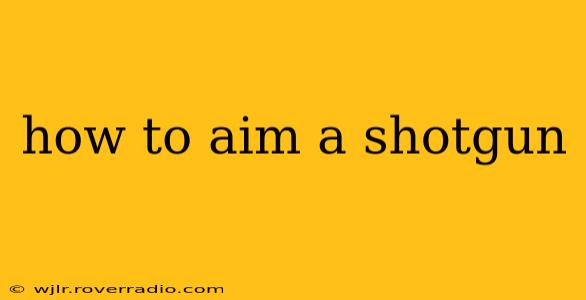Shotguns, with their wide spread and powerful impact, are unique firearms requiring a different aiming technique than rifles or handguns. Understanding how to effectively aim a shotgun is crucial for safe and accurate shooting. This guide will cover the fundamentals, addressing common questions and misconceptions.
What's Different About Aiming a Shotgun?
Unlike rifles, which rely on precise aiming at a specific point, shotguns are generally aimed at a wider area, using a technique often referred to as "pointing." This is because shotgun pellets spread out after leaving the barrel, creating a shot pattern (the area covered by pellets). Effective shotgun aiming focuses on getting the majority of your shot pattern to land on your target.
How to Point a Shotgun: The Fundamentals
The most effective method for aiming a shotgun is to point it, not aim it. This involves:
-
Mount the shotgun correctly: Shoulder the shotgun firmly and comfortably, ensuring a good cheek weld against the stock. Your body should be naturally aligned with the target.
-
Focus on the target: Don't look down the barrel. Instead, keep your focus directly on the target itself. This allows your natural point-of-aim to align with the target.
-
Use your body to align: Move your entire body to adjust your aim, rather than just trying to manipulate the gun itself. This allows for smoother and more accurate movements.
-
Practice proper stance: A stable, balanced stance is essential for consistent aiming. Experiment with different stances (like a square stance or isosceles stance) to find what feels comfortable and provides optimal stability.
-
Master the follow-through: Maintain your focus on the target even after you pull the trigger. This ensures that you remain in proper alignment during the recoil.
What is the Best Way to Aim a Shotgun at Moving Targets?
Aiming at moving targets requires anticipating their trajectory. This involves leading the target, essentially aiming slightly ahead of where the target will be by the time the shot reaches it. The amount of lead required depends on the target's speed and distance. This requires practice and experience.
How Far Can You Accurately Aim a Shotgun?
The effective range of a shotgun depends on the choke (the constriction at the end of the barrel) and the type of ammunition used. While a shotgun can technically hit targets at much greater distances, accuracy significantly decreases beyond 50 yards. For most hunting and sporting applications, aiming effectively is usually within the range of 25-40 yards.
What Type of Choke is Best for Aiming a Shotgun?
Different chokes produce different shot patterns. A modified choke is a versatile option, offering a good balance between range and pattern density. A full choke provides the tightest pattern, ideal for longer-range shots, but at the expense of a smaller overall area covered. A cylinder bore or improved cylinder offers a wider spread, perfect for closer-range targets. Choosing the correct choke depends on the shooting situation and your preferences.
How Does a Shotgun's Sight Picture Affect Aiming?
While many shotguns don't have complex sights, some feature bead sights or rib sights. These sights act as references for aiming, assisting in ensuring the gun is pointed correctly. Focus should remain on the target, but the sights can help you maintain consistency in your aiming technique.
How important is practice when aiming a shotgun?
Practice is paramount. Consistent practice is essential to master the technique of pointing and leading, to develop muscle memory, and to improve accuracy with your specific shotgun. Start at shorter ranges and gradually increase the distance as you improve your skills.
Conclusion
Mastering shotgun aiming isn't about precise aiming like with a rifle; it's about developing a natural point-of-aim and understanding how the shot pattern spreads. Practice, understanding your shotgun, and choosing the right choke are key elements in achieving accurate shots. Remember always to practice safe gun handling techniques and follow all relevant safety regulations.
